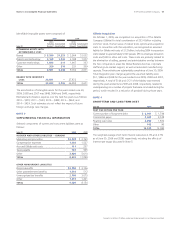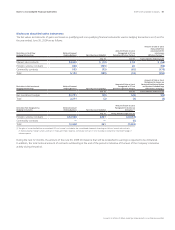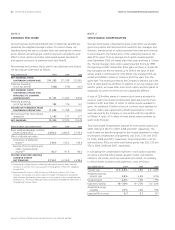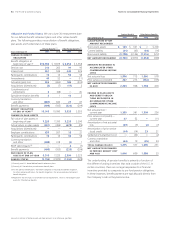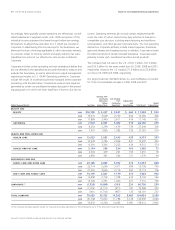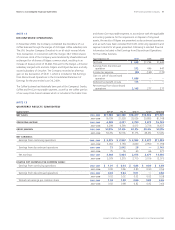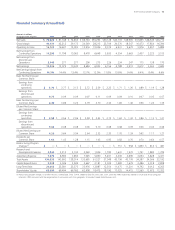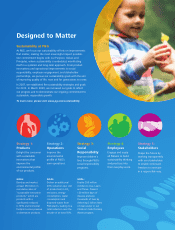Proctor and Gamble 2009 Annual Report Download - page 67
Download and view the complete annual report
Please find page 67 of the 2009 Proctor and Gamble annual report below. You can navigate through the pages in the report by either clicking on the pages listed below, or by using the keyword search tool below to find specific information within the annual report.
Notes to Consolidated Financial Statements The Procter & Gamble Company 65
Amounts in millions of dollars except per share amounts or as otherwise specified.
The accumulated benefit obligation for all defined benefit retirement
pension plans was $8,637 and $8,750 at June30,2009 and June30,
2008, respectively. Pension plans with accumulated benefit obligations
in excess of plan assets and plans with projected benefit obligations in
excess of plan assets consist of the following:
Accumulated Benefit
Obligation Exceeds the
Fair Value of Plan Assets
Projected Benefit
Obligation Exceeds the
Fair Value of Plan Assets
Years ended June 30 2009 2008 2009 2008
Projected benefit obligation $6,509 $5,277 $9,033 $7,987
Accumulated benefit
obligation 5,808 4,658 7,703 6,737
Fair value of plan assets 3,135 2,153 5,194 4,792
Net Periodic Benefit Cost. Components of the net periodic benefit
cost were as follows:
Pension Benefits Other Retiree Benefits
Years ended June 30 2009 2008 2007 2009 2008 2007
Service cost $214 $263 $279 $91 $95 $85
Interest cost 551 539 476 243 226 206
Expected return on
plan assets (473)(557)(454)(444)(429)(407)
Prior service
cost (credit)
amortization 14 14 13 (23) (21)(22)
Net actuarial loss
amortization 29 945 27 2
Curtailment and
settlement gain 6(36)(176)
—
(1)(1)
GROSS BENEFIT
COST (CREDIT) 341 232 183 (131)(123)(137)
Dividends on ESOP
preferred stock
—— —
(86) (95)(85)
NET PERIODIC
BENEFIT COST
(CREDIT) 341 232 183 (217)(218)(222)
Pursuant to plan revisions adopted during 2007, Gillette’s U.S. defined
benefit retirement pension plans were frozen effective January1, 2008,
at which time Gillette employees in the U.S. moved into the Trust and
ESOP. This revision resulted in a $154 curtailment gain for the year
ended June30, 2007.
Amounts expected to be amortized from accumulated other compre-
hensive income into net period benefit cost during the year ending
June30, 2010, are as follows:
Pension
Benefits
Other Retiree
Benefits
Net actuarial loss $92 $19
Prior service cost (credit) 15 (21)
Assumptions. We determine our actuarial assumptions on an annual
basis. These assumptions are weighted to reflect each country that
may have an impact on the cost of providing retirement benefits.
The weighted average assumptions for the defined benefit and other
retiree benefit calculations, as well as assumed health care trend
rates, were as follows:
Pension Benefits Other Retiree Benefits
Years ended June 30 2009 2008 2009 2008
ASSUMPTIONS USED TO
DETERMINE BENEFIT
OBLIGATIONS (1)
Discount rate 6.0% 6.3% 6.4% 6.9%
Rate of compensation increase 3.7% 3.7%
——
ASSUMPTIONS USED TO
DETERMINE NET PERIODIC
BENEFIT COST (2)
Discount rate 6.3% 5.5% 6.9% 6.3%
Expected return on plan assets 7.4% 7.4% 9.3% 9.3%
Rate of compensation increase 3.7% 3.1%
——
ASSUMED HEALTH CARE COST
TREND RATES
Health care cost trend rates
assumed for next year
——
8.5% 8.6%
Rate to which the health care
cost trend rate is assumed to
decline (ultimate trend rate)
——
5.0% 5.1%
Year that the rate reaches the
ultimate trend rate
——
2016 2015
(1) Determined as of end of year.
(2) Determined as of beginning of year and adjusted for acquisitions.
Several factors are considered in developing the estimate for the long-
term expected rate of return on plan assets. For the defined benefit
retirement plans, these include historical rates of return of broad equity
and bond indices and projected long-term rates of return obtained
from pension investment consultants. The expected long-term rates
of return for plan assets are 8%–9% for equities and 5% –6% for
bonds. For other retiree benefit plans, the expected long-term rate of
return reflects the fact that the assets are comprised primarily of
Company stock. The expected rate of return on Company stock is based
on the long-term projected return of 9.5% and reflects the historical
pattern of favorable returns.
Assumed health care cost trend rates could have a significant effect
on the amounts reported for the other retiree benefit plans. A one-
percentage point change in assumed health care cost trend rates
would have the following effects:
One-Percentage
Point Increase
One-Percentage
Point Decrease
Effect on total of service and interest cost
components $ 58 $(46)
Effect on postretirement benefit obligation 549 (447)




